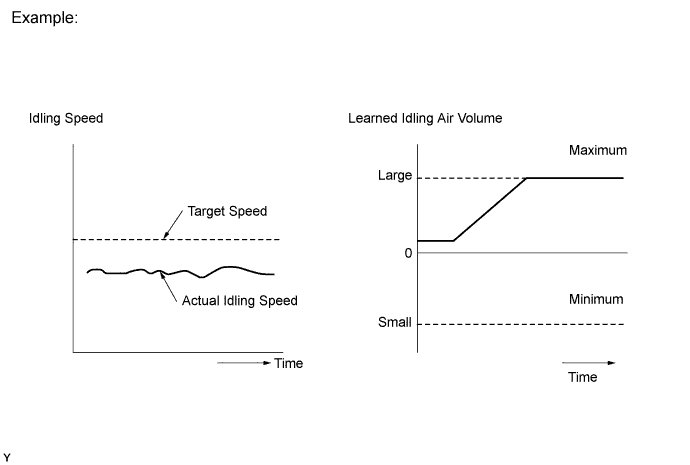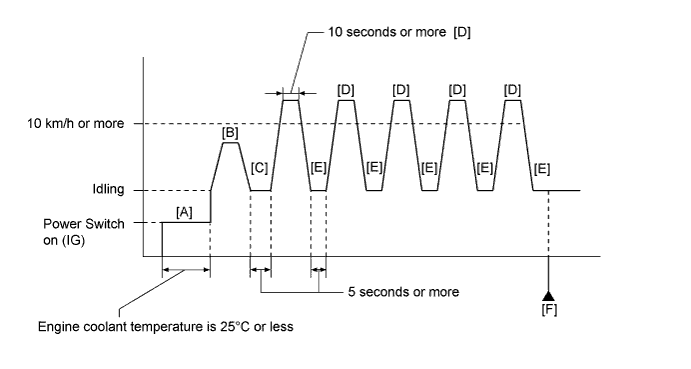DTC P0505 Idle Control System Malfunction
Description
The idle speed is controlled by the electronic throttle control system. The electronic throttle control system is comprised of: 1) the one valve type throttle body assembly; 2) a throttle actuator, which operates the throttle valve; 3) a throttle position sensor, which detects the opening angle of the throttle valve; 4) an accelerator pedal position sensor, which detects the accelerator pedal position; and 5) the ECM, which controls the electronic throttle control system. Based on the target idle speed, the ECM controls the throttle actuator to provide the proper throttle valve opening angle.
| DTC No. | DTC Detection Condition | Trouble Area |
| P0505 | Idling speed continues to vary greatly from target idling speed (2 trip detection logic). |
|
Monitor description
The ECM monitors the idling speed and idling air flow volume to conduct Idle Speed Control (ISC). The ECM determines that the ISC system is malfunctioning if the following condition is met:
- After driving at a vehicle speed of 10 km/h (6.25 mph) or more, the difference between the target and actual engine idling speed exceeds the threshold 5 times or more during a driving cycle, and then the system determines that the IAC flow rate learned value is stuck at the upper or lower limit, or that the IAC flow rate learned value has been changed by an amount that exceeds the threshold.

Monitor strategy
| Required Sensors/Components (Main) | Electronic throttle control system |
| Required Sensors/Components (Related) | Crankshaft position sensor Engine coolant temperature sensor Vehicle speed sensor |
| Frequency of Operation | Once per driving cycle |
| MIL Operation | 2 driving cycles |
Typical malfunction thresholds
| Both of following conditions A and B met | - |
| A. Frequency that both of following conditions (a) and (b) met | 5 times or more |
| (a) Engine speed - Target engine speed | Less than -100 rpm, or more than 150 rpm (A/C off and NSW off) Less than -100 rpm, or more than 200 rpm (A/C on or NSW on) |
| (b) Vehicle condition | Stopped after being driven at 10 km/h (6.25 mph) or more |
| B. Either condition is met | (c) or (d) |
| (c) IAC flow rate learned value | Lower limit or upper limit |
| (d) Amount of change of IAC flow rate learned value exceeds threshold | |
Confirmation driving pattern

- Connect the intelligent tester to the DLC3.
- Turn the power switch on (IG) and turn the tester on.
- Enter the following menus: Powertrain / Engine and ECT / Data List / Coolant Temp.
- Make sure that the coolant temperature is 25°C (77°F) or less [A].
- Clear the DTCs (even if no DTCs are stored, perform the clear DTC operation).
- Turn the power switch off and wait for 30 seconds.
- Turn the power switch on (IG) and turn the tester on.
- Put the engine in inspection mode (maintenance mode) .
- Start the engine and drive the vehicle until the coolant temperature reaches 70°C (158°F) [B].
CAUTION:
When performing the confirmation driving pattern, obey all speed limits and traffic laws.
HINT:
If the coolant temperature is 40°C (104°F) or higher, the engine may stop when idling.
- Stop the vehicle (0 km/h [0 mph]) for 5 seconds or more [C].
- Accelerate the vehicle to 10 km/h (6.25 mph) or more for 10 seconds or more [D].
CAUTION:
When performing the confirmation driving pattern, obey all speed limits and traffic laws.
HINT:
- When accelerating the vehicle, depress the accelerator pedal more than normal to start the engine.
- The engine may stop during acceleration. However, this will not affect the confirmation driving.
- Stop the vehicle (0 km/h [0 mph]) for 5 seconds or more [E].
- Repeat steps [D] and [E] for 5 times or more.
- Enter the following menus: Powertrain / Engine and ECT / DTC [F].
- Read the pending DTCs.
HINT:
- If a pending DTC is output, the system is malfunctioning.
- If a pending DTC is not output, perform the following procedure.
- Enter the following menus: Powertrain / Engine and ECT / Utility / All Readiness.
- Input the DTC: P0505.
- Check the DTC judgment result.
Tester Display Description NORMAL - DTC judgment completed
- System normal
ABNORMAL - DTC judgment completed
- System abnormal
INCOMPLETE - DTC judgment not completed
- Perform driving pattern after confirming DTC enabling conditions
UNKNOWN - Unable to perform DTC judgment
- Number of DTCs which do not fulfill DTC preconditions has reached ECU's memory limit
HINT:
- If the judgment result shows NORMAL, the system is normal.
- If the judgment result shows ABNORMAL, the system has a malfunction.
- If the judgment result shows INCOMPLETE or UNKNOWN, repeat steps [D] and [E] for 5 times or more.
Inspection procedure
HINT:
- The following conditions may also cause DTC P0505 to be set:
- The floor carpet overlapping slightly onto the accelerator pedal, causing the accelerator pedal to be slightly depressed and therefore the throttle valve position to be slightly open.
- The accelerator pedal being not fully released.
- Read freeze frame data using the intelligent tester. The ECM records vehicle and driving condition information as freeze frame data the moment a DTC is stored. When troubleshooting, freeze frame data can be helpful in determining whether the vehicle was running or stopped, whether the engine was warmed up or not, whether the air fuel ratio was lean or rich, as well as other data recorded at the time of a malfunction.
- Refer to "Data List / Active Test" [Engine Speed and ISC Learning Value] .
| 1.CHECK ANY OTHER DTCS OUTPUT (IN ADDITION TO DTC P0505) |
-
Connect the intelligent tester to the DLC3.
-
Turn the power switch on (IG).
-
Turn the tester on.
-
Enter the following menus: Powertrain / Engine and ECT / DTC.
-
Read the DTCs.
Result Result Proceed to DTC P0505 is output A DTC P0505 and other DTCs are output B HINT:
If any DTCs other than P0505 are output, troubleshoot those DTCs first.
|
|
||||
| OK | |
| 2.CHECK PCV HOSE CONNECTIONS |
-
Check the PCV hose connections.
OK:
PCV hose is connected correctly and is not damaged.
|
|
||||
| OK | |
| 3.CHECK INTAKE SYSTEM |
-
Check the intake system for vacuum leaks .
OK:
No leaks from the intake system.
|
|
||||
| OK | |
| 4.PERFORM ACTIVE TEST USING INTELLIGENT TESTER (CONTROL THE EGR STEP POSITION) |
-
Connect the intelligent tester to the DLC3.
-
Turn the power switch on (IG).
-
Turn the tester on.
-
Put the engine in inspection mode (maintenance mode) .
-
Start the engine and warm it up until the engine coolant temperature reaches 75°C (167°F) or higher.
HINT:
The A/C switch and all accessory switches should be off.
-
Enter the following menus: Powertrain / Engine and ECT / Active Test / Control the EGR Step Position / Data List / All Data / Throttle Idle Position and MAP.
-
Confirm that the Throttle Idle Position is ON and check the engine idling condition and MAP values in the Data List while performing the Active Test.
HINT:
- Do not leave the EGR valve open for 10 seconds or more during the Active Test.
- Be sure to return the EGR valve to step 0 when the Active Test is completed.
- Do not open the EGR valve 30 steps or more during the Active Test.
OK:
MAP and idling condition change in response to EGR step position when Throttle Idle Position is ON in Data List.
Standard:
- EGR Step Position (Active Test) 0 Steps 0 to 30 Steps Idling condition Steady idling Idling changes from steady to rough idling or stalls MAP (Data List) MAP value is 20 to 40 kPa (150 to 300 mmHg) (EGR valve is fully closed) MAP value is at least +10 kPa (75 mmHg) higher than when EGR valve is fully closed HINT:
During Active Test, if the idling condition does not change in response to EGR step position, then there is probably a malfunction in the EGR valve.
Result Result Proceed to Outside of standard range A Within standard range B
|
|
||||
| OK | |
| 5.INSPECT EGR VALVE ASSEMBLY |
-
Remove the EGR valve assembly .
-
Check if the EGR valve is stuck open.
OK:
EGR valve is tightly closed.
|
|
||||
| OK | |
| 6.INSPECT THROTTLE BODY ASSEMBLY |
-
Check for contamination between the throttle valve and the housing and then check that the throttle valve moves smoothly.
OK:
Throttle valve is not contaminated with foreign objects and moves smoothly.
|
|
||||
| OK | |
| 7.CONFIRM WHETHER MALFUNCTION HAS BEEN SUCCESSFULLY REPAIRED |
-
Connect the intelligent tester to the DLC3.
-
Turn the power switch on (IG).
-
Turn the tester on.
-
Clear the DTCs .
-
Drive the vehicle in accordance with the driving pattern described in the Confirmation Driving Pattern.
-
Enter the following menus: Powertrain / Engine and ECT / DTC.
-
Read the pending DTCs.
Result Result Proceed to DTC P0505 is output A DTC is not output B
|
|
||||
| A | |
|